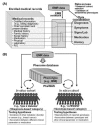Perspectives on clinical informatics: integrating large-scale clinical, genomic, and health information for clinical care
- PMID: 24465229
- PMCID: PMC3897845
- DOI: 10.5808/GI.2013.11.4.186
Perspectives on clinical informatics: integrating large-scale clinical, genomic, and health information for clinical care
Abstract
The advances in electronic medical records (EMRs) and bioinformatics (BI) represent two significant trends in healthcare. The widespread adoption of EMR systems and the completion of the Human Genome Project developed the technologies for data acquisition, analysis, and visualization in two different domains. The massive amount of data from both clinical and biology domains is expected to provide personalized, preventive, and predictive healthcare services in the near future. The integrated use of EMR and BI data needs to consider four key informatics areas: data modeling, analytics, standardization, and privacy. Bioclinical data warehouses integrating heterogeneous patient-related clinical or omics data should be considered. The representative standardization effort by the Clinical Bioinformatics Ontology (CBO) aims to provide uniquely identified concepts to include molecular pathology terminologies. Since individual genome data are easily used to predict current and future health status, different safeguards to ensure confidentiality should be considered. In this paper, we focused on the informatics aspects of integrating the EMR community and BI community by identifying opportunities, challenges, and approaches to provide the best possible care service for our patients and the population.
Keywords: clinical data warehouse; database; electronic health records; medical informatics.
Figures

Similar articles
-
The future of Cochrane Neonatal.Early Hum Dev. 2020 Nov;150:105191. doi: 10.1016/j.earlhumdev.2020.105191. Epub 2020 Sep 12. Early Hum Dev. 2020. PMID: 33036834
-
A review of electronic medical record keeping on mobile medical service trips in austere settings.Int J Med Inform. 2017 Feb;98:33-40. doi: 10.1016/j.ijmedinf.2016.11.008. Epub 2016 Nov 30. Int J Med Inform. 2017. PMID: 28034410 Review.
-
Are privacy-enhancing technologies for genomic data ready for the clinic? A survey of medical experts of the Swiss HIV Cohort Study.J Biomed Inform. 2018 Mar;79:1-6. doi: 10.1016/j.jbi.2017.12.013. Epub 2018 Jan 10. J Biomed Inform. 2018. PMID: 29331453
-
Hickam 2000: the maturation of, and linkages between, medical informatics and bioinformatics.J Lab Clin Med. 2001 Dec;138(6):359-66. doi: 10.1067/mlc.2001.120048. J Lab Clin Med. 2001. PMID: 11753282
-
Interventions to improve the use of EMRs in primary health care: a systematic review and meta-analysis.BMJ Health Care Inform. 2019 May;26(1):0. doi: 10.1136/bmjhci-2019-000023. BMJ Health Care Inform. 2019. PMID: 31142493 Free PMC article.
Cited by
-
Networks as Biomarkers: Uses and Purposes.Genes (Basel). 2023 Feb 8;14(2):429. doi: 10.3390/genes14020429. Genes (Basel). 2023. PMID: 36833356 Free PMC article. Review.
-
Consensus Statement on Electronic Health Predictive Analytics: A Guiding Framework to Address Challenges.EGEMS (Wash DC). 2016 Mar 7;4(1):1163. doi: 10.13063/2327-9214.1163. eCollection 2016. EGEMS (Wash DC). 2016. PMID: 27141516 Free PMC article.
-
Biomedical Data Sharing and Reuse: Attitudes and Practices of Clinical and Scientific Research Staff.PLoS One. 2015 Jun 24;10(6):e0129506. doi: 10.1371/journal.pone.0129506. eCollection 2015. PLoS One. 2015. PMID: 26107811 Free PMC article.
-
Migrating a research data warehouse to a public cloud: challenges and opportunities.J Am Med Inform Assoc. 2022 Mar 15;29(4):592-600. doi: 10.1093/jamia/ocab278. J Am Med Inform Assoc. 2022. PMID: 34919694 Free PMC article.
-
A Machine Learning Approach for Predicting In-Hospital Cardiac Arrest Using Single-Day Vital Signs, Laboratory Test Results, and International Classification of Disease-10 Block for Diagnosis.Ann Lab Med. 2025 Mar 1;45(2):209-217. doi: 10.3343/alm.2024.0315. Epub 2024 Dec 13. Ann Lab Med. 2025. PMID: 39668659 Free PMC article.
References
-
- Laakko T, Leppänen J, Lähteenmäki J, Nummiaho A. Mobile health and wellness application framework. Methods Inf Med. 2008;47:217–222. - PubMed
-
- Hood L, Galas D. The digital code of DNA. Nature. 2003;421:444–448. - PubMed
-
- Weston AD, Hood L. Systems biology, proteomics, and the future of health care: toward predictive, preventative, and personalized medicine. J Proteome Res. 2004;3:179–196. - PubMed
Publication types
LinkOut - more resources
Full Text Sources
Other Literature Sources
